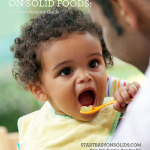 Introducing a new food to your baby is an “iffy” thing. He might adore green beans the first time he eats them, and gobble them up with relish. On the other hand, he might spit them right back out and give you his biggest glare.
Introducing a new food to your baby is an “iffy” thing. He might adore green beans the first time he eats them, and gobble them up with relish. On the other hand, he might spit them right back out and give you his biggest glare.
There’s no way to predict how your baby will react to new foods. But there are steps you can take to help your baby enjoy her new food as much as possible.
-
Offer the breast or a bottle before offering a new food.
This is good advice to follow anyway (especially when you’re first starting solid foods.) The idea here is that your baby will be calmer and more receptive to solid food if he’s not totally hungry. It’s especially important to do this when you’re about to offer him something new.
-
Offer new foods when your baby is well-rested.
You know by now that when your baby’s exhausted, nothing goes well. And feeding is no different! So pick a time during the day when you know your baby will be rested and happy — maybe after her morning nap — and offer the brand-new food then. This will help ensure she has the positive attitude and patience she’ll need to try something new.
-
Offer a small amount of the new food.
Feeding your little guy spinach for the first time? This is not the moment to make a big ol’ serving! Instead, prepare a half-sized portion of the new food. If your baby loves it, you can always make more; if he isn’t so receptive, you won’t be wasting a bunch of leftover food. And as you feed the new food to your baby, offer half-sized spoonfuls — just enough to give him a taste.
-
Alternate a new food with a familiar one.
If you’ve got a stubborn baby on your hands who simply doesn’t embrace new foods, you may have to resort to a few tricks to get a new food into her belly! This trick is simple: you prepare two dishes of food, one being a food that she’s familiar with, and the other being a food that’s new. As you begin to feed, offer a few spoonfuls of the familiar food first. Then, offer a spoonful of the new food. Follow it up with another spoonful of the familiar food.
This can help “soften the blow” of a new food. You might find that your baby is willing to take a few spoonfuls of the new food if she also gets spoonfuls of something that’s familiar, and that she likes. This is also a good technique to use when you’re feeding baby something she’s tried before and hates. I use this trick a lot with my youngest, who’s a major vegetable-hater!
-
Be calm and stay patient.
It can be so frustrating trying to feed a baby a food he clearly doesn’t like. You know he needs to eat his broccoli, but he has other ideas! But it’s important that you remain patient and calm throughout a feeding that isn’t going well. Our babies are smart, and they tend to pick up on our own anxiety. If your baby senses your frustration, it’ll likely only make things worse.
-
Don’t give up — keep trying!
Your baby may reject avocado the first time you offer it, but that doesn’t mean she’ll refuse the third or fourth (or fifth) time you try. If a feeding isn’t going well, it’s okay to put away the new food for the day and take a break. But you should bring it out a day or two later, and try again. Experts agree that it often takes a baby a few tries to develop a taste for something new.
Everything You Need To Know About Starting Solids – All In One e-Book!
 What if you could find everything you needed to know about starting your baby on solid foods – when it’s best to start solids, how to introduce solids, complications, food allergies, etc. – in one easy-reference guide? Now you can! Your Baby’s Start To Solid Foods: A Comprehensive Guide will walk you through every step of starting solids. Plus, your e-Book package includes several bonus materials, designed to maximize your success in starting solids. You’ll get a thorough guide to treating constipation, a dietitian’s advice on how to avoid 5 common solid-foods mistakes, and a weekly meal plan for your baby’s first year. Grab your e-Book today, and ensure your baby has the healthiest possible start to solid foods!
What if you could find everything you needed to know about starting your baby on solid foods – when it’s best to start solids, how to introduce solids, complications, food allergies, etc. – in one easy-reference guide? Now you can! Your Baby’s Start To Solid Foods: A Comprehensive Guide will walk you through every step of starting solids. Plus, your e-Book package includes several bonus materials, designed to maximize your success in starting solids. You’ll get a thorough guide to treating constipation, a dietitian’s advice on how to avoid 5 common solid-foods mistakes, and a weekly meal plan for your baby’s first year. Grab your e-Book today, and ensure your baby has the healthiest possible start to solid foods!








